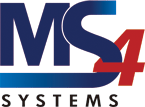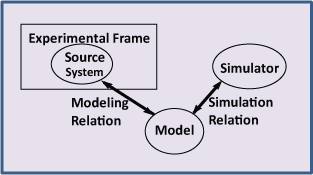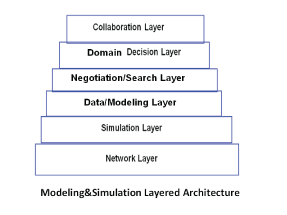
Complex Information Technology (IT) based business, engineering, and military systems are at the root of this century's global challenges of economy, climate and energy. We are used to building such systems directly in the real world and letting use and Mother Nature tell us how good they are. Increasingly, however, it is getting too dangerous, costly, unethical, or risky to do so. "Build and test within virtual reality" is more and more the only workable alternative where by "virtual" we include a wide range of representations of the eventual fielded reality including models wholly within a single computer, network distributed emulations, physically analogous and immersive environments. Modeling and Simulation (M&S) supply the basis for such environments. Computer based modeling refers to the construction of such environments while computer simulation connotes the experimentation using them to study alternative designs and architectures.
Introduced in the last century as a rigorous systems-theory basis for discrete event modeling and simulation, the DEVS (Discrete Event System Specification) formalism has become an engine for advances in M&S technology and the support of "build and test in virtual reality." A variety of systems theory and artificial-intelligence applications employing DEVS-based concepts were compiled by Sarjoughian and Cellier [1]. However, the wealth of research continues to expand and an updated accounting of recent advances seems in order.
However, you as today's web and smart phone sophisticated reader, will question what a pricey collection of papers on DEVS will provide that an apparently free Google search of the internet will not. As an M&S researcher, you will get not only a sampling of the best research in the area, but also a broader overview of this research that provides a picture of the DEVS landscape what has been done, what has this opened up to be done in the future. As an M&S practitioner, you will see a variety of exciting new applications that were enabled by the DEVS approach, and that may inspire you to make similar application advances in your own area of interest.
We'll start with a review of core DEVS concepts and pointers to where you can pursue this background in greater depth. We will then provide relate the research and application contributions to this core to give a sense of where it all fits. Finally, we summarize, draw some inferences and make some predictions of where DEVS work will evolve to support the "build and test in virtual reality."
DEVS Core
The core of DEVS consists of basic concepts, the broader M&S framework, and the Systems-theory basis.
Basic Concepts
Discrete Event Systems Specification (DEVS) is a modeling formalism just as arithmetic underlies addition, multiplication, and other calculation, so DEVS underlies simulation of discrete event models.
DEVS Simulation: The Abstract DEVS Simulator is a technology-agnostic description of a correct DEVS simulator or simulation engine in the same way that a calculator program is executing an algorithm that describes its operation in terms that abstract away the implementation details.
System Entity Structure (SES) is a high level ontology framework targeted to modeling, simulation, systems design and engineering. An SES is a formal structure governed by a small number of axioms that provide clarity and rigor to its models. The structure supports hierarchical and modular compositions allowing large complex structures to be built in stepwise fashion from smaller, simpler ones.
M&S Framework and Systems Theory Basis
Modeling and Simulation Framework provides a set of entities (real system, model, simulator, and experimental frame (EF)) and relations among the entities (model validity, simulator correctness, among others) that, in effect, present ontology of the modeling and simulation domain. DEVS models can be atomic, coupled and hierarchical. The Simulation Relation specifies what constitutes a correct simulation of a model by a simulator. The Model Relation determines when a model can be said to be a valid representation of source system within an experimental frame. The framework entities are formulated in terms of the system specifications provided by systems theory, and the framework relations are formulated in terms of the morphisms (preservation relations) among system specifications. System specification morphisms allow us to check consistency between models and frames as well as between frames at different resolutions. This capability becomes especially important when components are composed together in distributed simulation federations. Computational support for this framework is based on the mathematical theory of systems and works with object orientation and other computational paradigms.

Hierarchy of System Specifications: Table 1 reviews the hierarchy of system specifications drawn from Theory of Modeling and Simulation. Generally, transitioning from higher to lower levels in the specification hierarchy, i.e., from structure to behavior, involves working out explicitly what is implicit in the given description. On the other hand going from lower to higher levels, i.e., from behavior to structure, presents an under-constrained problem, requires adding new structure to what is given, and can be characterized as a search rather than a computation. The systems specification hierarchy provides a basis for understanding the types of problems that are encountered in applying modeling and simulation to systems development, engineering, management, and testing.
| Name | System Specification at this level | |
| Coupled Systems | System built from component systems with coupling recipe. | |
| I/O System Structure | System with state and state transitions to generate the behavior. | |
| I/O Function | Collection of input/output pairs constituting the allowed behavior partitioned according to initial state of the system. | |
| I/O Behavior | Collection of input/output pairs constituting the allowed behavior of the system from an external Black Box view. | |
| I/O Frame | Input and output variables and ports together with allowed values. | |
Advances in DEVS Radiating Out From the Core
This site provides chapters divided into theory, methodology, and applications that all relate to this core.

As illustrated in the figure, radiating out from the core are areas of research in theory and methodology, each with applications, as well as an outer ring of trend setting applications. Let's briefly discuss the areas in counterclockwise order starting at the top center.
DEVS Interaction with Other Methodologies- System Design and Development
- UML-MDA combined with DEVS
- DEVS, UML, and Developer Specializations
- Progressive Model continuity
- JAMES - plug-ins for software platform frameworks
- Graph Transformation Model Generation
- Graph Transformation Executed by DEVS Real Time
- Partitioning strategies
- Dynamic load balancing
- Moving time windows (MTW), Filter algorithm
- Event Queues specifically for DEVS simulator structures
- Exploiting specialized DEVS classes
- The alternative algorithms and data structures for DEVS underline the importance of developing these:
- Alternative implementations may speed up the simulation process of DEVS models significantly.
- Alternative implementations may allow larger DEVS models to be computed.
- There is no algorithm/data structure optimal for every model.
- DEVSJava
- DEVSSim++
- ADEVS
- CD++
- DevsPython
- Web-Based Implementations
- Discrete Flow System Specification (DFSS), a modular formalism able to describe hierarchical event-based systems with a time-varying structure.
- DEVS Stochastic System
- DynDevs
- ml-Devs
- epi-Devs
- Effective and efficient modeling and simulation of DEVS variants
- Multi-formalism modeling
- Meta modeling model transformation
- Approaches to model composability are classified into mono, super, meta, and poly modeling formalisms
- SES search/Model Generation
- Dynamic Structure DEVS
- Structure and Parameter Optimization
- System Identification
- Control Applications Quantized Systems
M&S Layered Architecture
The M&S Layered Architecture is another organizing concept for placing the work into understandable relationships. Here is a brief overview of this architecture:

Network Layer includes networks, sensors, and computing devices, organized in grids, clouds, service oriented architectures, that do the work of supporting all aspects of the M&S lifecycle.
Simulation Layer is the software that executes the models to generate and analyze their behaviors in both virtual and real time. Included in this layer is the DEVS simulation protocol that provides the basis for correct local and distributed execution.
Data and Modeling Layer supports the development of data ontologies, experimental/pragmatic frames, and models in the DEVS formalisms that are separated from, but compliant with, the simulation layer protocol but agnostic with respect to its implementation.
Negotiation and Search Layer supports the user in formulating Pragmatic Frame specifications characterizing data needs and negotiates with data sources to discover data to meet these specifications; supports the user in formulating experimental frames and discovery of model components meeting frame specifications; supports searches through space of model compositions for candidates meeting frame specified criteria.
Domain Decision Layer enables the decision maker to interact with, and apply the results of, lower layer processing to make decisions and solve systems problems within the particular application domains that are being addressed.
Collaboration Layer enables participants to bring to bear individual perspectives and contributions to make decisions and solve problems based upon the functionalities provided by the underlying layers.
| M&S Architectural Layer | Areas covered in MS4Systems | How they contribute |
| Methodology for Working with M&S Architecture |
DEVS Interaction with Other Methodologies DEVS Model Development Support |
|
| Network Layer | ||
| Simulation Layer | Parallel, Distributed, Real Time Simulation DEVS Implementations Interoperability and Composability |
|
| Data and Modeling Layer | Extensions New Formalisms Interoperability and Composability DEVS Theory and Analysis |
|
| Negotiation and Search Layer | Search and Optimization | |
| Decision Layer | Applications | |
| Collaboration Layer | ||
Conclusions, Inferences and Predictions
DEVS is a base for the development of specialized modeling formalisms for specific domains- Specialized DEVS may be useful for a plethora of applications
- The strict separation of models and simulators facilitates the development of alternative algorithms to dramatically speed up the simulation of DEVS models
- DEVS as a semantic domain for other formalisms
- precise and powerful semantics
- efficient and robust implementation
- includes time virtual and real
DEVS popularity denotes a right level of definition
- abstract enough to allow the development of new concepts and structures
- precise enough to avoid ambiguities and guide modelers
- Because of the increasing complexity of hardware and software architectures, meta-levels (and automatic mappings from higher to lower levels) need to be designed.
Considering complex systems as multi-level and highly composed, detecting and mapping simulation structures to their underlying activity will be more and more necessary.
Activity tracking mechanisms will allow improving DEVS efficiency and abstraction.

